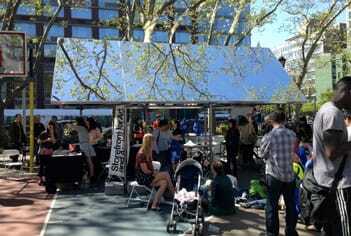
A panel of current and former public leaders considered the concept of “untapped capital” in the context of their cities. Moderated by Kurt Anderson of WNYC’s Studio 360 (far left), the panel included (from right) Manuel Diaz, former mayor of Miami (and ULI Rose Center National Advisory Board member); Christophe Girard, mayor of Paris’s Fourth District and former deputy mayor for culture of Paris; Jim Gray, mayor of Lexington, Kentucky; Bill Purcell, former mayor of Nashville; and Will Wynn, former mayor of Austin.
In early May, New York City’s New Museum hosted the second Ideas City Festival. Founded in 2011 with the belief that arts and culture are integral to the vitality and impact of urbanization, this biennial four-day festival of conferences, workshops, and street festivals has an ambitious objective to collaborate with arts, education, and civic organizations in the surrounding community—in this case, the Bowery—for the purpose of exploring the future of the city.
This year’s festival focused on the theme “Untapped Capital” and how cities inherently have underrecognized or underused resources that communities can tap to support diversity and sustainability.

As part of the Ideas City Festival, Storefront for Art and Architecture and the New Museum, in collaboration with Architizer, held a “tenting competition.” The winning design (shown here) was “MirrorMirror” by design firm Davidson Rafailidis of Buffalo, New York, which sheltered many project presentations in the streets around the New Museum and in Sara D. Roosevelt Park.
The festival was kicked off with a conference laying out four primary topics—ad hoc strategies, waste, play, and youth—that would permeate proceeding workshops and project presentations, then culminated with a grand StreetFest around the New Museum in the Bowery neighborhood.
The conference’s keynote speaker, Joi Ito, director of the MIT Media Lab and a leading thinker in both technology investment and online creativity, challenged attendees to stop and think about the word capital. Use of the word, which is primarily an economic term, is now pervasive, said Ito, but its connotation cannot be the same with regard to community as it is for venture investments. He said technological advances have decentralized personal networks and, thus, the processes of innovation.“The general principles of economic investment are no longer relevant,” he said. Instead, he offered that this new system, or the “after-internet age,” lowers the barriers to capital and allows more individuals to access resources that support self-organization, collaboration, and production. Thus, “capital,” as it relates to community, is the civil infrastructure that enables creative risk-taking, learning, convening, and networking.
With more than 100 events presented by local private and public institutions, the New Museum embodied this underlying point. It may be taken for granted that the complexity and pace of life in New York enables creativity at the fringes of its systems, but through the festival’s coordination, the New Museum created a space where innovators and citizen spectators could interface and participate.
A few standout projects presented at this year’s event merit an online visit:
- The Architectural League/Urban Omnibus staffed a pop-up exhibition at the StreetFest showcasing the first stage of the Architectural League’s long-term project Typecast, a research-based study seeking to refresh thinking about architectural typologies that have come to be seen as outdated, starting with the much-maligned housing typology “towers-in-the-park.” The booth presented photographs from five photo essays (one project from each borough) commissioned for Typecast, and offered an outline of the project’s research agenda. You can learn more about the program on the Urban Omnibus website.
- Architizer and the Municipal Arts Society hosted an evening project in which five teams of architects presented their innovative urban schemes to a public audience that voted to select its favorite. Titled “Pitching the City: New Ideas for New York,” the team projects were also presented to a selection jury—Nick Denton, Gawker.com; Pat Kiernan, NY1; Roy Kim, Extell; Nazli Parvizi, Mayor’s Community Affairs Unit; Christopher Sharples, SHoP Architects; Megan Sheekey, Mayor’s Fund to Advance New York City; Yeohlee Teng, designer.asks—who will choose a winner to present the best proposal at the annual MAS Summit for New York City in October. The projects can be viewed on the Architizer blog.
- The Center for Architecture previewed the “Future of the City” exhibit highlighting design and policy ideas for significant issues facing the city’s built environment. The exhibition is a piece of a larger symposium held in conjunction with the NYCxDESIGN. While part of the discussion highlighted the connection between design and public policy, recommendations of the interdisciplinary Post-Sandy Initiative report were also summarized. The report and information about the “Future of the City” exhibit can be found on the AIA New York/Center for Architecture website.


